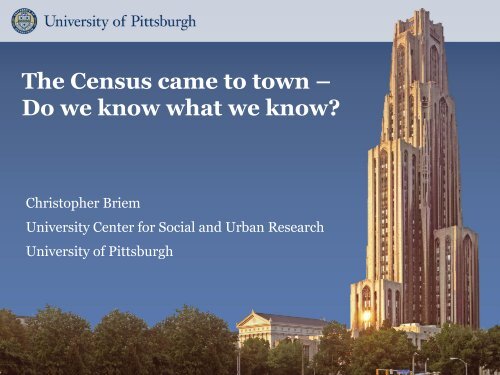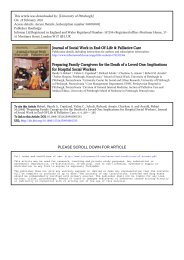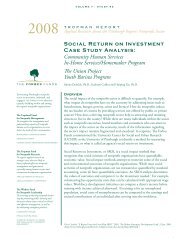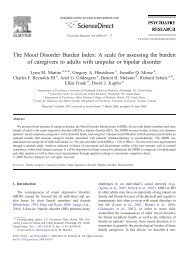The Census came to town – Do we know what we know?
The Census came to town – Do we know what we know?
The Census came to town – Do we know what we know?
You also want an ePaper? Increase the reach of your titles
YUMPU automatically turns print PDFs into web optimized ePapers that Google loves.
<strong>The</strong> <strong>Census</strong> <strong>came</strong> <strong>to</strong> <strong>to</strong>wn <strong>–</strong><strong>Do</strong> <strong>we</strong> <strong>know</strong> <strong>what</strong> <strong>we</strong> <strong>know</strong>?Chris<strong>to</strong>pher BriemUniversity Center for Social and Urban ResearchUniversity of Pittsburgh
<strong>The</strong> <strong>Census</strong> <strong>came</strong> and <strong>we</strong>nt <strong>–</strong><strong>Do</strong> <strong>we</strong> <strong>know</strong> <strong>what</strong> <strong>we</strong> <strong>know</strong>?Chris<strong>to</strong>pher BriemUniversity Center for Social and Urban ResearchUniversity of Pittsburgh
This Presentation• Living without the long form census• What the American CommunitySurvey tells us….. and <strong>what</strong> it doesnot• Pittsburgh Neighborhood Profiles• Data still <strong>to</strong> come
<strong>The</strong> Basics from <strong>Census</strong> 2000• Short Form<strong>–</strong> Survey of 100% of the population<strong>–</strong> Questions about the basic demographiccharacteristics• Long Form<strong>–</strong> Sample of one in six housing units(approximately 17% sample)<strong>–</strong> Basic demographic questions<strong>–</strong> Virtually all economic questions
<strong>The</strong> Basics from <strong>Census</strong> 2010• Short Form<strong>–</strong> Survey of 100% of the population<strong>–</strong> Questions about the basic demographiccharacteristics only• Long Form<strong>–</strong> Sample of one in six housing units(approximately 17% sample)<strong>–</strong> Basic demographic questions<strong>–</strong> Virtually all economic questions
American Community Survey• A nationwide, continuous monthly survey• Samples 3 million addresses per year or250,000 addresses each month.• Data will be released annually forcommunities of 65,000 or more people• Profiles available for 3 year period averagesfor communities with fe<strong>we</strong>r than 65,000people but more than 20,000• Smaller places (
Why ACS?• Disadvantages include<strong>–</strong> Smaller sample frame <strong>–</strong> larger sample errors<strong>–</strong> Multiple reporting periods<strong>–</strong> Not perfectly consistent with decennial dataproducts• Advantages include:<strong>–</strong> No longer 10 year gap in data<strong>–</strong> Professional data collection should reduce selfreportingerrors<strong>–</strong> Cost of long form for entire population
Neighborhood data
Comparing ACS and Decennial <strong>Census</strong>• Decennial census counts everyone• Decennial references a single point in time(April 1)• ACS sample size is smaller <strong>–</strong> 1 in 8• ACS data is supplied with ―margin oferror‖• ACS data is an average over 1, 3, or 5 years• ACS should be used <strong>to</strong> reference―characteristics‖, not absolute counts
Just remember…• Best <strong>to</strong> compare similar estimates:<strong>–</strong> Example: Compare 3-year estimates <strong>to</strong> 3-year estimates• Be careful about comparing over time:<strong>–</strong> <strong>Do</strong> not compare overlapping estimates (e.g.,2005-2007 & 2006-2008)<strong>–</strong> <strong>Do</strong> compare 2005-2007 & 2008-2010• Which estimate you choose can changethe s<strong>to</strong>ry!
Point in time versus Period data• Decennial data is point in time—April 1• ACS is period data<strong>–</strong> Data collected almost daily<strong>–</strong> Information is anchored <strong>to</strong> day on whichsample housing unit was intervie<strong>we</strong>d. So,―last 12 months‖ depends on when theinterview occurs.• Important when comparing data like:employment, income, and studentenrollment.
What Data is available now:• <strong>Census</strong> 2010 Redistricting Data (decennial)<strong>–</strong> Total Population, by race, and broken down by votingage population• ACS 2005-2009 Data<strong>–</strong> Via <strong>Census</strong> Factfinder for tract level data<strong>–</strong> Block Group Data available via <strong>Census</strong>/FTP<strong>–</strong> UCSUR neighborhood profiles now available• Group Quarters Data (decennial)• <strong>Census</strong> 2010 Age Detail (just released)
Decennial Population by NeighborhoodNeighborhood 2000 2010 ChangeGarfield 5,384 3,675 -1,709 -31.7%Northview Heights 2,565 1,214 -1,351 -52.7%Homewood North 4,620 3,280 -1,340 -29.0%Golden Triangle* 4,874 3,629 -1,245 -25.5%Saint Clair 1,435 209 -1,226 -85.4%Homewood South 3,549 2,344 -1,205 -34.0%Brookline 14,320 13,214 -1,106 -7.7%Perry South 5,244 4,145 -1,099 -21.0%East Liberty 6,937 5,869 -1,068 -15.4%Hazelwood 5,334 4,317 -1,017 -19.1%
UCSUR Profiles:• ACS 2005-2009 Data• All 90 Neighborhoods• „Meta‟ Neighborhoods• Selected Tables• Online this morning/A few copies here
Some ACS-Decennial <strong>Census</strong> DifferencesDecennial ACSNeighborhood 2010 2005-2009 DifferenceSquirrel Hill North 11,363 12,793 -1,430Brookline 13,214 14,462 -1,248Brigh<strong>to</strong>n Heights 7,247 8,366 -1,119Saint Clair 209 1,064 -855Bloomfield 8,442 9,202 -760Fairywood 1,002 400 602Golden Triangle* 3,629 2,856 773Marshall-Shade. 6,043 4,868 1,175Central Oakland 6,086 4,794 1,292North Oakland 10,551 8,945 1,606
Know your neighborhood• ACS sample errors can significantly changemetrics for neighborhoods/smallareas/small groups.• Different data sources may appear verydifferent (decennial vs. ACS)• Some errors happen (<strong>Do</strong>wn<strong>to</strong>wn 2000example)
Coming in the future• This Summer: Interactive Neighborhood Data<strong>to</strong> go with UCSUR profiles and other Decennialdata• Through 2011: From <strong>Census</strong> Bureau: Morebreakouts of 2010 Decennial <strong>Census</strong> data.• Fall 2011: ACS 2006-2010 Data (based on newgeography and population controls!!)
Looking for data?• <strong>Census</strong> Factfinder:http://factfinder.census.gov• Our Pittsburgh Urban Blog:http://www.ucsur.pitt.edu/thepub.php• PNCIS -> “Neighborhood reports”http://www.ucsur.pitt.edu/pncis.php







